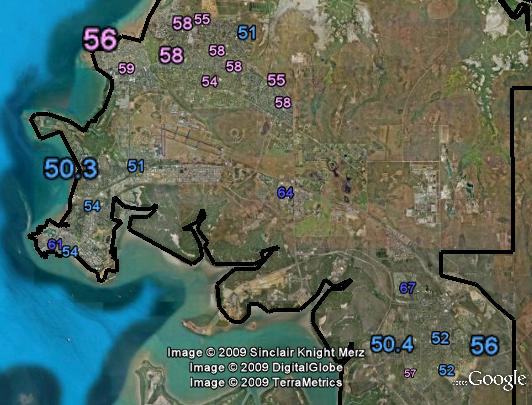ALP 0.2%
Incumbent MP
Damian Hale, since 2007.
Geography
Solomon covers the Darwin metropolitan area, as well as the nearby city of Palmerston.
Demographics
Solomon has a high concentration of defence facilities, and the largest concentration of defence employees in the country.
History
The Northern Territory first elected a Member of the House of Representatives in 1922, but this person was only given full voting rights in 1968. The seat was held by the Country Party and then the Country Liberal Party from then until 1983, before Labor and then the CLP each held the seat for one term, before Warren Snowdon won the seat for the ALP in 1987. Snowdon lost the seat for one term in 1996 before being returned for one more term in 1998. The 2000 redistribution saw the Northern Territory gain a second seat for the first time, and the seats of Solomon, covering Darwin and Palmerston, and Lingiari, covering the rest, were created. In 2001, Country Liberal candidate Dave Tollner won the seat by only 88 votes. In 2004, he increased his margin to 2.8%. The 2007 election saw Tollner lose his seat to the ALP’s Hale.
Candidates
- John Kearney (One Nation)
- Emma Young (Greens)
- Damian Hale (Labor) – Member for Solomon since 2007.
- Natasha Griggs (Country Liberal) – Deputy Mayor of Palmerston.
- Trudy Campbell (Citizens Electoral Council)
Political situation
Solomon is the ALP’s third most marginal seat in Australia.
2007 result
| Candidate | Party | Votes | % | Swing |
| David Tollner | CLP | 24,109 | 46.80 | -1.95 |
| Damian Hale | ALP | 21,581 | 41.90 | +3.37 |
| Debbie Hudson | GRN | 4,672 | 9.07 | +2.30 |
| Maurice Foley | IND | 545 | 1.06 | -0.44 |
| Jacques Chester | LDP | 358 | 0.70 | +0.70 |
| Trudy Campbell | CEC | 245 | 0.48 | +0.01 |
| FF | 0 | 0.00 | -2.09 | |
| DEM | 0 | 0.00 | -1.86 |
2007 two-candidate-preferred result
| Candidate | Party | Votes | % | Swing |
| Damian Hale | ALP | 25,853 | 50.19 | +3.00 |
| David Tollner | CLP | 25,657 | 49.81 | -3.00 |
Booth breakdown
Solomon’s voters clearly divide into geographical areas. The northern suburbs of Darwin, which made up 40% of the voters, strongly voted for the ALP. In contrast, the southern suburbs of Darwin, as well as the satellite city of Palmerston, voted strongly for the Country Liberal Party. Tollner also won a majority of other votes cast, which mainly consisted of postal votes.
| Voter group |
ALP 2CP % |
Total votes cast |
% of votes |
| North Darwin | 55.94 | 21,029 | 40.83 |
| Palmerston | 47.04 | 10,578 | 20.54 |
| South Darwin | 45.66 | 10,018 | 19.45 |
| Other votes | 45.92 | 9,885 | 19.19 |



Do you know what makes Palmerston so much stronger for the conservatives? Is that where all the defence personell are located?
Looking at the census figures, yes, there is a higher proportion of defence employees in Palmerston (11% of the workforce). Also Palmerston, compared with Darwin city, is less ethnically diverse, has significantly less people employed in professional occupations, and appears to have a very low proportion of fully-owned private dwellings (7.5% vs 32.6% across Australia) – could that be due to defence housing? I’m not familiar enough with the NT though to offer any other observations there.
The CLP have chosen Palmerston Deputy Mayor Natasha Griggs as their candidate:
http://www.abc.net.au/news/stories/2009/11/30/2757206.htm
No other comments here?
My prediction: Labor retain, negligible swing.